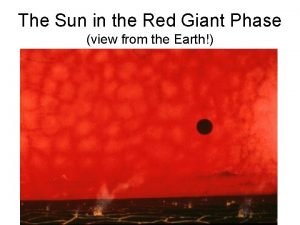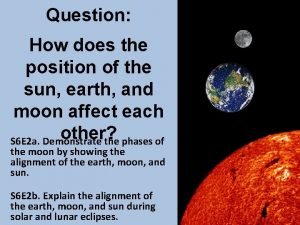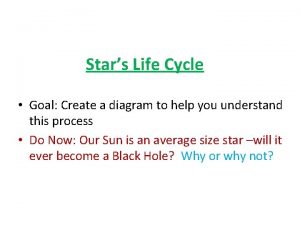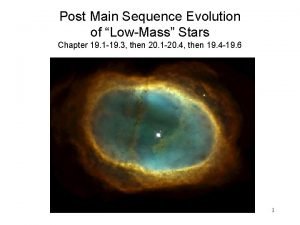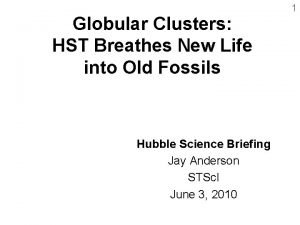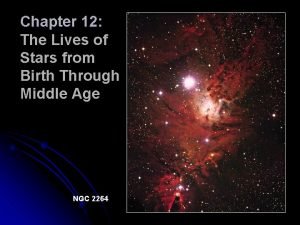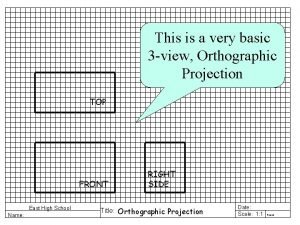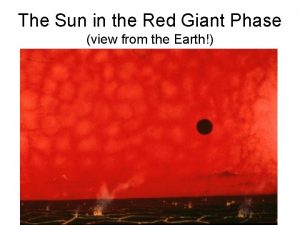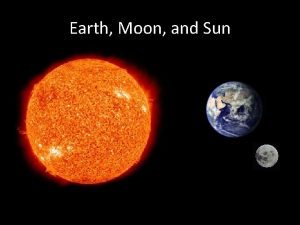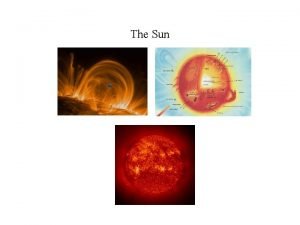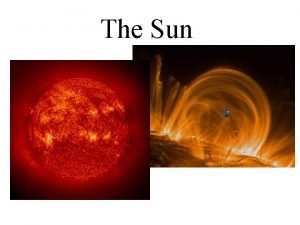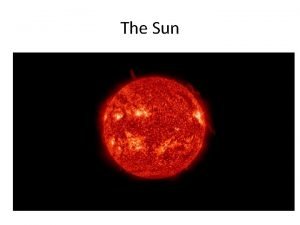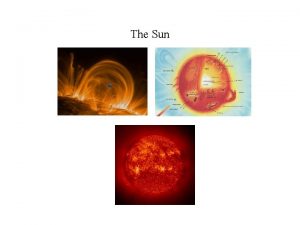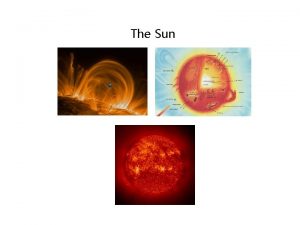The Sun in the Red Giant Phase view































- Slides: 31

The Sun in the Red Giant Phase (view from the Earth!)

Evolution Low-Mass Stars Beyond the Main Sequence • M < 4 M_Sun • Once the star reaches the MS, it spends most of its lifetime in the H He nuclear burning phase • When the hydrogen in the center is exhausted, the star forms a He-core and the H-burning shell moves outward; the envelope expands and cools; the core contracts and heats; star becomes a Red Giant moving up from the MS • Helium in the center of core remains inert until the density, pressure, and temperature increase to 108 K needed to ignite it Helium Flash

Helium Burning: Triple-a Reaction • Intermediate step: Beryllium formation 4 He + 4 He 8 Be + energy (photons) • Fusion to Carbon 8 Be + 4 He 12 C + energy g (photons) • Helium core is highly dense and electrons are packed together in a degenerate state • Electrons as close together as possible and therefore exerting degeneracy pressure against further gravitational contraction • But temperature rises explosive He burning

He-Burning: He C Triple-Alpha (He-nuclei) Reaction At temperatures T > Oxygen: 108 K Notation: 4 He 2 2 protons + 2 neutrons # Protons: Atomic Number in Periodic Table The most energetic electromagnetic radiation or g-rays are produced in nuclear reactions

Solar-type star

Main Sequence Lifetime of Solar-type Star


Helium Flash

Low-Mass Stellar Evolution


Evolution beyond the Red Giant • L does not increase at the onset of the He-flash itself since the central region of the core is quite opaque • The H-burning shell is slowly extinguished and L decreases, even as the star shrinks and temperature rises; the star moves leftward along a nearly Horizontal Branch on the H-R diagram • Luminosity rises again as the energy from the Heburning core of the RG rises to the surface • The star then resumes its climb up the H-R diagram along a second vertical branch – the Asymptotic Giant Branch (AGB)

Evolution Beyond the AGB Phase • He-burning via the triple-alpha fusion is highly temperature sensitive • The AGB star is unstable; radiation pressure from the interior push away the envelope – hot core separates from the envelope • Hot core is mainly C-O (products of triple-alpha) • Hot core is very luminous initially, but rapidly cools through a Planetary Nebula (PN) phase (NO relation to planets!) • The PN C-O core surrounded by the brightly lit ejected envelope appears as a ‘ring’ • The PN core cools and collapses to White Dwarf


Central Star and Spherical Ejected Shell

Cat’s Eye Planetary Nebula

Planetary Nebulae and White Dwarfs • The ring shaped PN is ionized and heated by the hot central core; takes about 10, 000 years • Hot PNe have C-O stellar core at about 100, 000 K • Moves left on the H-R diagram as it is exposed • Moves BELOW the MS as it cools, shrinks, and becomes less luminous • Matter in the cold core is ‘degenerate electron gas’, not an ideal gas; Pressure is independent of temperature; contraction of the core stops when the pressure equals gravity; star becomes White Dwarf • R (WD) ~ 0. 01 R (Sun) ~ R (Earth) • WD cools away into a ‘stellar corpse’ ! BUT, may turn into a huge DIAMOND (Carbon crystal) !!

Pne WD Tracks



Ages of Stellar Clusters • H-R diagram yields information on L, M, T, R, and color of stars; most characteristics except age • But may determine the age of a stellar cluster, formed at the same time and composition, from the evolution of stars in the cluster with different masses isochrones • High mass stars evolve off the MS (“turn off”) before low mass stars

Evolution and nucleosynthesis of High Mass Stars • Very different structure and evolution from low mass star • Mass more than about 4 times M(Sun), but luminosity up to 10, 000 times L(Sun) or more • Burn brightly, evolve rapidly, die relatively quickly • CNO cycle is more efficient in H He fusion than the p -p chain; requires higher temperatures prevalent in cores of high-mass stars • At over 600 million K elements heavier than CNO are fused, e. g. 12 C + 12 C 24 Mg + energy

H He Nuclear Fusion Via the C-N-O Cycle in Massive Stars e+ positron Positive electron annihilates negative electron (matterantimatter) e- + e + = g energy Ordinary Isotopes: 12 C, 14 N, 16 O act as catalysts

Evolution of Supergiants: Constant Luminosity


Evolution of Supergiants Beyound He-buring

Evolution of High-Mass Stars Beyond the MS • M > 4 M (Sun) – O and B stars • Burn H He via the more efficient CNO cycle • After H-core exhaustion the He-core contracts and heats up, but the H-burning continues around the He -core and the star puffs up • The star expands and cools, but the luminosity remains constant since the huge outer layers are opaque • It moves right on the H-R diagram as a Red Supergiant • Takes about a million years to cross the H-R diagram

Blue Supergiant Phase • Core temperature reaches T > 100 million K; the He -flash ignites He-burning to C and O via the Triple-alpha nuclear fusion reaction • With a H-burning shell, a He-burning core, the star builds up a C-O core and becomes a Blue Supergiant, moving leftward on the H-R diagram, following the He-flash • After He-core exhaustion, the C-O core collapses and heats up, with H and He burning outer shells, and the star expands and becomes a Red SG again, moving right on the H-R diagram • Carbon ignites when core T > 600 MK, density > 150, 000 g/cc

Crisscrossing the HR Diagram

Intermediate and High Mass Stars A dichotomy emerges: 1. Intermediate mass star: 4 M(Sun) < M < 8 M(Sun) - Carbon burning reactions produce O, Ne, Mg - no further burning, inert O-Ne-Mg core WD, after about 1000 years 2. High mass stars: M > 8 -10 M(sun) - evolve rapidly with strong stellar winds (radiation driven) - O-Ne-Mg core heats up to T ~ 1. 5 billion K, density ~ 10 million g/cc, and ignites Neon burning to Mg and Si; lasts only a few years - Oxygen shell burns up to Si, S, P…(Si-core)


SUPERNOVA Fiery Explosive Death of Massive Stars • In M > 8 M(Sun) stars the Si-core ignites and burns up to Fe-Ni • No further fusion possible since fusion beyound iron requires energy rather than produce it • Once an iron-core has been formed, the star no longer has any fuel source • When M (Fe-core) > 1. 4 – 2 M(Sun), the Fe core contracts, heats up, and explodes…. SUPERNOVA • The envelope is ejected and the iron core collapses into; Neutron Star or BLACK HOLE • BH if M (core) > 3 M(Sun)
 Red giant phase
Red giant phase Is sun a red giant
Is sun a red giant Moon giant phase
Moon giant phase One sees his finish unless good government retakes the ship
One sees his finish unless good government retakes the ship Star cycle diagram
Star cycle diagram Post
Post Red giant
Red giant Red giant
Red giant Normal phase vs reverse phase chromatography
Normal phase vs reverse phase chromatography Hplc reverse phase vs normal phase
Hplc reverse phase vs normal phase Mobile phase and stationary phase
Mobile phase and stationary phase Hplc definition
Hplc definition Normal phase vs reverse phase chromatography
Normal phase vs reverse phase chromatography Phase to phase voltage
Phase to phase voltage Hplc detector types
Hplc detector types Phase to phase voltage
Phase to phase voltage Broad phase vs narrow phase
Broad phase vs narrow phase Top view is directly above the front view
Top view is directly above the front view Hidden lines are not generally omitted in a sectional view
Hidden lines are not generally omitted in a sectional view What is a removed section view
What is a removed section view Section cutting line symbol
Section cutting line symbol Birds eye angle
Birds eye angle End elevation view
End elevation view Isometric projection in engineering drawing
Isometric projection in engineering drawing For the view create view instructor_info as
For the view create view instructor_info as Simple view and complex view
Simple view and complex view Simple view and complex view
Simple view and complex view Simple view and complex view
Simple view and complex view Partial view in mvc
Partial view in mvc X ray indication
X ray indication Scm cycle view
Scm cycle view Components of os
Components of os
